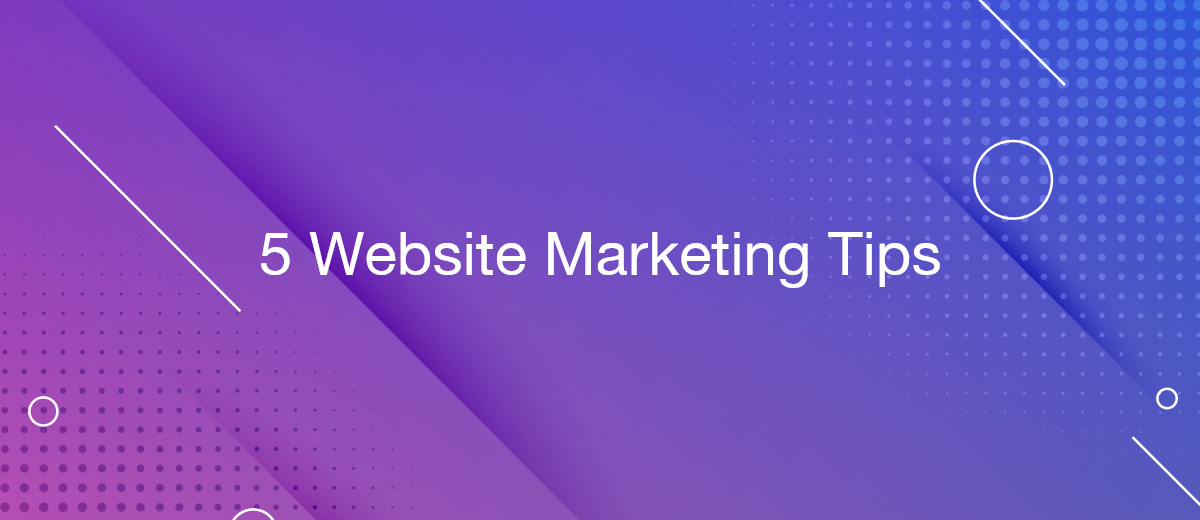5 Website Marketing Tips to Drive Traffic and Increase Conversions
Effective website marketing has become indispensable for businesses aiming to thrive online. With countless websites vying for attention, understanding how to draw the right traffic and transform it into tangible results is paramount. A well-executed website marketing approach can help drive qualified traffic to your site, which can be converted into leads and customers. This article will explore five potent website marketing tips that can propel your online venture toward success, amplifying traffic and conversions.
What is Website Marketing?
Website marketing is the promotion of a website through techniques like SEO and social media marketing. These techniques aim to make your site more visible. The more visible your site, the higher your chances you’ll get website visitors.
Once these visitors land on your website, the aim is to encourage them to take specific actions. This could include making a purchase, signing up for a newsletter, downloading a resource, or any other action that aligns with your business goals. Effective website marketing not only draws visitors in but also engages them in a way that aligns with your business objectives, turning traffic into valuable conversions.
5 Website Marketing Tips

In the quest for a thriving online presence, implementing effective digital marketing strategies for your website is essential. Below are five tactics that can elevate your website's visibility for more conversions.
1. Optimize Website for Search Engines
If you’re serious about driving more traffic to your site, you will prioritize Search Engine Optimization (SEO). SEO is the process of improving your website’s position in search engine results pages. Ultimately, when you rank higher in search engine results pages, you get more traffic and potential conversions.
Whether your site has an eCommerce, SaaS or manufacturing web design, you’ll need to focus on three main aspects of SEO to make it rank. These are:
- Technical SEO - In technical SEO, you improve the technical aspects of your site to help search engine bots crawl and index your pages with ease. You’ll need to work on your site speed, ensure there are no dead links, add structured data if necessary, and create an XML sitemap.
- Offsite SEO - With offsite SEO, you’ll work on elements outside your site that can help with your rankings. The biggest factor here is link-building. This involves acquiring backlinks from other top sites. Quality backlinks signal to search engines that your site is high-quality and valuable. This results in better rankings. Guest posts can help you build backlinks.
- Onsite SEO - Onsite SEO involves optimizing the elements within your site to make it search engine-friendly. For example, you must improve internal linking and enhance your site structure to help search engine crawlers understand your site better. You’d also need to write optimized content. We’ll talk more about content marketing in the next section.
Research shows that 53 percent of all website traffic comes from organic searches. So, SEO is a strategy you can’t ignore if you want increased conversions.
2. Post Engaging Content on your Website
We can’t talk about search engine optimization without mentioning content marketing as part of your on-site SEO strategy. Content marketing involves creating helpful content to attract and engage your target market. The content can range from blog posts to infographics and videos. Although content marketing can involve the use of different platforms, in this section, let’s focus on your website.
So, how exactly does engaging website content help you drive traffic and increase conversions? Let’s say you sell pet products. As part of your content marketing, you’d produce blog posts pet owners would be interested in. Creating a lot of this content gives you topical authority, allowing you to rank for relevant keywords. The engaging content can also attract authoritative backlinks, which Google considers a ranking factor. The result of all these? You rank in search engine results pages and increase your website’s visibility. You, therefore, attract the right traffic that can convert.
In the context of writing blog posts, here are some key characteristics of engaging content:
- Relevance: To ensure relevance, make sure your content addresses your target audience’s interests, needs, and pain points.
- Visual Appeal: Use visual elements such as images, videos and infographics. They break up the text, make content more digestible, and capture attention quickly.
- Clarity: Avoid overly complex language and explanations. Also, break up your blog post into H2s and H3s for better readability and structure.
Keeping your website content fresh is key, too. This involves a delicate balance between timely updates and evergreen content creation. Evergreen content is content that remains relevant and valuable over an extended period.
3. Leverage Social Media for Marketing and Relationship-Building
We’ve talked about how creating engaging content on your site helps you drive traffic to it and increase conversions. You can do the same if you post engaging content on your social media channels as part of your content marketing.
- Automate the work of an online store or landing
- Empower through integration
- Don't spend money on programmers and integrators
- Save time by automating routine tasks
Posting engaging content across social media helps you tap into a diverse online audience who might just get curious about your brand and search for your site. If you post links to your site, they might just click through the links, too. In other words, engaging social media content can help you get website traffic and, subsequently, more conversions.
You can post just about anything on social media, such as polls, quizzes, and company updates. You can even promote your recently-published website blog posts, too. Whatever type of content you post, just make sure to use relevant hashtags to broaden your reach.
But don’t just use social media for posting content. Use it to interact with your audience as well. By responding to comments and messages, you build a sense of community around your brand. These are, again, people who are more likely to go to your site and convert.
4. Utilize Paid Advertising
Paid ads help you target specific users who are closer to making a purchase decision. This makes paid ads a great option for marketers looking for a quick ROI. When they see your ad, then, they’ll likely click through to your website and take your desired action.
You can run paid ads on different platforms, including Google search results, social media platforms and other websites. One common type of paid ads are Pay-Per-Click (PPC) ads. With PPC advertising, you bid on relevant keywords, ensuring your ads appear for specific search terms. The most commonly used PPC ad networks are Google Ads, LinkedIn Ads, and Instagram Ads.
Wherever you choose to run a paid ad campaign, follow these tips to ensure success:
- Set goals: Do you want to increase traffic or brand awareness? What will you measure to determine campaign success? Will it be your conversion rate, signups, demo bookings, etc..?
- Use the right ad copy: Incorporate the right keywords into your copy to ensure your ads appear when people make relevant searches. Use a clear call-to-action.
- Optimize PPC landing pages for conversions: Make sure the page is relevant to the ad. Incorporate social proof if you can. Use a good CTA.
- Test your campaign: Using analytics tools, check whether your campaign is meeting your original goals. If it isn’t, make tweaks like changing your ad or landing page copy.
You can also use paid advertising to run remarketing campaigns. Remarketing campaigns position your ads in front of users who have previously visited your site, nurturing their interest and encouraging return visits.
5. Use Email Marketing
Email marketing remains reliable for driving prospective customers to your site. The average email marketing conversion rate is around 8%. For effective email marketing as a business owner, create lead magnets to build your email list. Lead magnets are resources that your audience would be willing to trade their email addresses for. For example, it could be white papers or a free tool.
With your email list ready, start working on the email campaign. Here are some tips to follow:
- Segment your email list: Divide your email list into smaller segments based on demographics, behavior, purchase history, or engagement level. This allows you to send targeted and relevant content to each group, increasing the chances of engagement.
- Personalize email content: Use the recipient's name and tailor the content to their preferences and behavior. You can also personalize based on past interactions, such as recommending products related to their previous purchases.
- Craft compelling subject lines: Make your subject line attention-grabbing, concise, and relevant to the content of the email. It should build curiosity and communicate the clear benefits of opening the email. E.g. “Unlock 20% More Sales with this Proven Marketing Strategy”
- Use clear call-to-action (CTA): Each email should have a compelling CTA that guides the reader on the desired action, whether it's making a purchase or downloading content.
- Monitor and analyze results: Regularly track key metrics like open rates, click-through rates, conversion rates, and unsubscribe rates. Use this data to refine your strategy and improve future campaigns.
Balance promotional content with value-driven information in your email marketing campaigns. Don’t forget to verify email addresses with an email finder before hitting that Send button, too. You want to make sure your emails reach your intended recipients.
Conclusion
The success of your online presence hinges on your ability to attract potential customers and convert them. This article has shown you how to market your website to drive qualified traffic and boost conversions. From SEO, creating engaging content, and social media marketing to paid advertising and email marketing, these tactics are guaranteed to boost your site’s rankings and visibility. It’s now time to put them into action!
Strive to take your business to the next level, achieve your goals faster and more efficiently? Apix-Drive is your reliable assistant for these tasks. An online service and application connector will help you automate key business processes and get rid of the routine. You and your employees will free up time for important core tasks. Try Apix-Drive features for free to see the effectiveness of the online connector for yourself.


